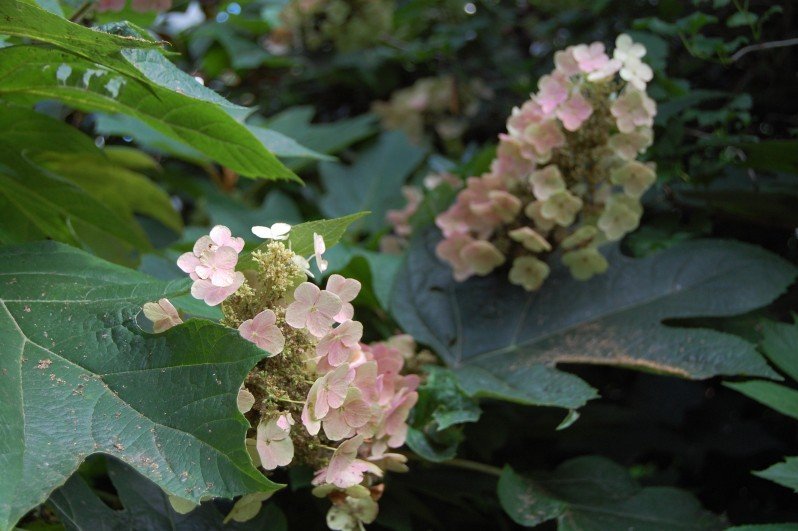FALL GARDEN CHORES
Take advantage of a crisp Fall day to get out in your garden and prepare it for Winter.
PRUNE
Cut back to about 2 inches any perennials that have browned or those that look ratty, such as Hosta, Peonies and perennial Ferns. It is OK to cut back the rest of the perennials now too, if you would like to get it all over with at one time. But if you don’t mind getting back out there in late Winter, you can leave those perennials still adding interest to the garden. Some perennials still looking good include Japanese Anemone (Anemone japonica), Catmint (Nepeta), Russian Sage (Perovskia atriplicifolia), Salvia, Monkshood (Aconitum napellus), Hardy Geranium and Iris.

I was surprised when I saw that the scarlet color blazing in the garden was Hardy Geranium (Cranesbill). The stems and leaves are bright red — I never noticed before!
Cut back the foliage of Evergreen Ferns and Lenten Rose (Helleborus) ONLY if it has begun to turn brown. The new (and some of the old) foliage on these plants will look beautiful throughout the Winter.

Autumn Fern (Dryopteris erythrosora) is evergreen. It stands out in the Winter garden (but the fronds may break under the weight of ice or heavy snow).
Prune Annabelle Hydrangeas (Hydrangea arborescens) to about 2 feet.
You can prune the everblooming Hydrangeas now. The plants bloom on new wood (stems that develop on the plant in the current season’s growth), so they should still produce blooms next Summer.
You can also prune Limelight and Tardiva Hydrangea (Hydrangea paniculata) now. These Hydrangeas also bloom on new wood, thus they can be pruned without sacrificing bloom anytime except late Spring and early Summer (when buds are set). To keep as a 4 to 5 foot shrub, prune back to about 2 to 3 feet. To train as a small tree, remove lower branches, and spindly or crossing interior branches.

This Limelight Hydrangea was pruned the prior November to about 3 feet. It produced smaller blooms, but a more graceful shrub.
Do not prune other Hydrangeas now (Lacecap, Mophead, Oakleaf), unless removing dead or diseased branches, or you will be cutting off next year’s blooms.
Shrub Roses can be lightly pruned now, with a harder pruning in late Winter. Many of the Shrub Roses will look beautiful until we get a real hard freeze, and so they can be left alone, or lightly trimmed to neaten the straggly branches.
PLANT
Now is a great time to plant. Plant Spring-flowering bulbs anytime until the ground is too frozen to work.

Tabb Farinholt donated Grape Hyacinth and Daffodil Bulbs to St. Christopher’s School, then helped the boys plant them. They didn’t plant these until late January, yet they bloomed just a couple of months later.
Divide perennials (such as Hosta, Iris, Catmint, Daylilies), or transplant perennials that have spread (such as Lamb’s Ears, Japanese Anemone, Hellebores, Ferns). Either add these to other areas of the garden, or share them with friends.
Now is a great time to plant trees and shrubs. My only concern is that you use your judgment when choosing the plants. I’m wary of buying deciduous plants if they have lost their leaves or if they are in the process of going dormant, because I can’t tell how healthy the plants are. Only buy plants that are robust and healthy.
Replace Summer annuals with Pansies, Ivy and/or evergreens in your containers. The Pansies will thrive until the weather gets really cold, and will rebound when temperatures warm again. The evergreens and trailing Ivy will look good all winter.
NURTURE MOTHER EARTH
Rake or blow leaves onto your lawn, run them over with your lawn mower, then mulch your beds with the shredded leaves to a depth of about two inches. The mulch provides nutrients to the soil and Winter protection to the plants. You also save money on mulch and fertilizer, and save the City from the expense of picking up and disposing of leaves. Now THAT’S recycling!
Install a rain barrel, directing a gutter to empty into the barrel. If you live in the City of Richmond, you can get credit against your Stormwater Assessment if you use this or other methods to retain stormwater on your property.
Feed the birds, either with a bird feeder, or by providing fruit-bearing plants.

Capturing stormwater on your property helps protect the James River and the Blue Herons who make it their home







